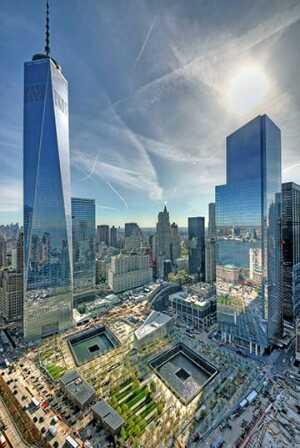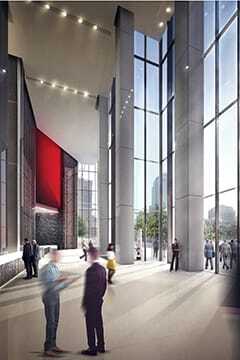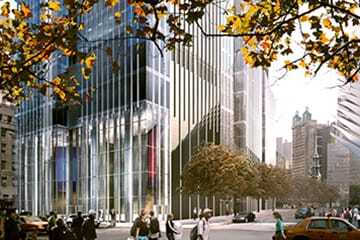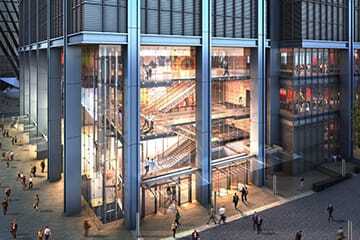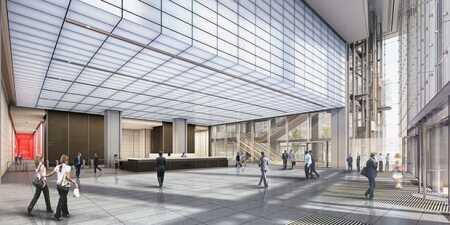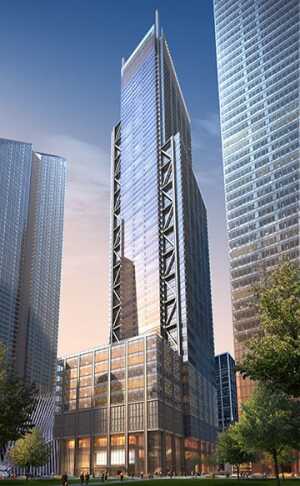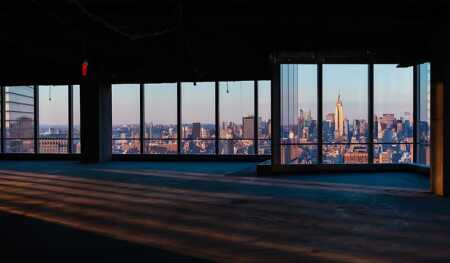Thirteen years after terrorist attacks leveled the World Trade Center’s twin towers, a redrawn skyline is emerging in lower Manhattan, led by the gleaming new One World Trade Center rising from the site. Along with that architectural—and emotional—milestone, the reputation of lower Manhattan is receiving a makeover.
The office submarket, also often called downtown Manhattan, was once known exclusively as a center for financial firms whose workers cleared out of the area en masse at nightfall.
These days, a rapidly diversifying tenant base is changing that reputation. Nowhere is the shift more apparent than in that centerpiece, the 104-story, 3 million-square-foot (279,000 sq m) skyscraper formerly known as Freedom Tower.
At a symbolic 1,776 feet (541 m), One World Trade Center will be officially recognized as the tallest tower in the Western Hemisphere when it opens late this year. It will be anchored not by one of the world’s financial behemoths, but by Condé Nast, whose magazine titles include the New Yorker, Vogue, Vanity Fair, Architectural Digest, Bon Appetit, and Glamour.
“It’s really becoming the ‘it’ place versus the lower-cost alternative,” says office broker Hal Stein, a managing principal at Newmark Grubb Knight Frank (NGKF) who leads the New York City–based brokerage’s lower Manhattan office. “It’s not your grandfather’s downtown anymore. In the past it was financial services, financial services, financial services. Now it’s everybody.”
Condé Nast will be the first tenant to move in when it takes over nearly 1.2 million square feet (111,000 sq m) on the 20th to 44th floors, relocating from Times Square starting this fall. The lease, signed in 2011, was a coup for the developers—the Port Authority of New York and New Jersey and the New York City–based Durst Organization—and not just because the lease filled more than one-third of the tower.
“It was huge,” Douglas Durst, chairman of the Durst Organization, says of the lease’s overall impact on lower Manhattan. “The phrase that was constantly used was ‘game changer.’ It really opened the market to media tenants that I don’t think would have gone there had Condé Nast not broken the ice and gone down there.”
Moving onto the 16-acre (6.5 ha) World Trade Center campus was not the first pioneering move in the career of Condé Nast’s now-retired chairman, Si Newhouse. “When he moved to Times Square in 1994, it was unheard of for a media company of [Condé Nast’s] prestige to move to Times Square,” Durst says. “It was not regarded as an office market. So he’s done it twice.”
The magazine publisher will not be alone in the area among companies in the so-called TAMI (technology, advertising, media, and information) sector. Such companies have helped lower Manhattan bring in 6.9 million square feet (641,000 sq m) of relocations since 2011, while losing just 1.9 million square feet (177,000 sq m) to move-outs, for a net gain of 5 million (464,000 sq m), according to Los Angeles–based brokerage CBRE. The TAMI sector has accounted for 47 percent of all office relocations to the area since 2011, more than any other sector, according to the Alliance for Downtown New York.
“Some of it is momentum,” says office broker Adam Foster, a CBRE senior vice president. “You get a herd mentality.”
The influx of creative tenants is lifting not just trophy towers like One World Trade Center, but historic structures as well. “Now some Class B buildings are leasing at a higher price than some types of Class A buildings,” Stein says. “Tenants are not necessarily looking for glass and steel. They’re looking for older buildings with lots of columns, exposed ceilings, and polished concrete floors. Older buildings are really what a lot of the TAMI sector is looking for.”
Time Inc.—whose magazines include Entertainment Weekly and People—signed a lease for 700,000 square feet (65,000 sq m) of space in Brookfield Place across the street from the World Trade Center. In another sign of the times, that four-tower office complex had been renamed from World Financial Center by New York City–based owner Brookfield Office Properties, the largest landlord in lower Manhattan with 13.4 million square feet (1.3 million sq m) of space in its portfolio.
One World Trade Center is 56 percent leased, including a deal with advertising agency KiDS Creative for 34,775 square feet (3,000 sq m) of space. The U.S. General Services Administration has leased 272,995 square feet (25,000 sq m). China Center New York, a Chinese business and cultural center set up by Beijing-based residential and commercial developer Vantone Holdings, will take up about 200,000 square feet (19,000 sq m).
Legends Hospitality—which will operate One World Observatory, the tower’s observation decks on floors 100 to 102—leases 4,759 square feet (442 sq m) of office space. Legends is a sports entertainment company that provides concessions, retail merchandise, sales, and marketing to sports venues; its owners include the New York Yankees and Dallas Cowboys. One World Observatory will offer views from 1,250 feet (381 m) above street level when it opens in the spring.
One World Trade Center’s total height was not officially recognized until a philosophical dispute over its architecture was resolved in November 2013. The Chicago-based Council on Tall Buildings and Urban Habitat called together an international committee of architects who have the final say on building heights. The council’s height committee ruled that the 408-foot (124 m) needle at the top of One World Trade Center is a spire, a structure that is included in a tower’s height. Had the committee deemed the top to be an antenna, the 1,451-foot (442 m) Willis Tower in Chicago—formerly known as the Sears Tower, which was the world’s tallest building from 1973 until 1996—would have remained the tallest in the United States.
These days, One World Trade Center’s owners are focused on the more economically pressing issue of leasing up the tower.
Durst says that more than a decade removed from 9/11, which wiped out more than 11 million square feet (1 million sq m) of office space, tenants’ attitudes about working in the World Trade Center’s tallest tower have evolved. He says potential office tenants express fewer concerns about the potential for attacks than they once did. “It’s a lot less than it was earlier on, but people still ask about it,” Durst says. “We’re able to show this is the safest building in New York City. Obviously, we’re convincing tenants to take space there.”
Other recent lower Manhattan leases involving tenants outside the financial sector include a deal for 515,000 square feet (48,000 sq m) by advertising firm GroupM at New York City–based Silverstein Properties’ planned 3 World Trade Center; Macmillan Science and Education’s 176,121 square feet (16,000 sq m) and cosmetics company Revlon’s 90,194 square feet (8,000 sq m) at Brookfield’s One New York Plaza; and marketing firm Media Math’s 106,000 square feet (10,000 sq m) at Silverstein’s 4 World Trade Center.
Earlier this year, HarperCollins Publishers moved its headquarters to 185,000 square feet (17,000 sq m) of space at 195 Broadway, a landmark building owned by Boston-based Beacon Capital Partners and New York City–based L&L Holding.
New Street Vitality
Creative workers looking to linger after work can find waterfront jazz concerts, movie nights, and barbecues, says Tara Stacom, an executive vice chairman at New York City–based brokerage Cushman & Wakefield, which represents One World Trade Center’s owners in leasing.
“Downtown was really missing from a lot of New Yorkers’ schedules,” Stacom says. “There are New Yorkers who hadn’t been in downtown in years, or even a decade. The financial services firms’ [employees] used to always leave at the end of the day and commute back to the suburbs. Now it’s where the millennial generation not only wants to work, but also where they want to live and socialize afterward.”
Some traditional deals continue as well, such as Bank of New York Mellon’s lease, signed in June, for 346,607 square feet (32,200 sq m) of space to move to Brookfield Place after deciding to sell its headquarters on Wall Street.
That is part of 3 million square feet (279,000 sq m) of leases signed in a 12-month period for Brookfield, a record for the company and about triple the typical volume, says Dennis Friedrich, Brookfield’s chief executive officer. The trend has helped the firm backfill much of the 3 million square feet (279,000 sq m) of leased space held by Merrill Lynch that expired at Brookfield Place last year. Merrill Lynch was acquired by Charlotte, North Carolina–based Bank of America in 2009, which substantially reduced its need for space in Manhattan.
Downtown’s vacancy rate improved to 12.7 percent at the end of the second quarter, down from 15.8 percent a year earlier, according to CBRE. Year-to-date leasing totaled 3.52 million square feet (327,000 sq m), 43 percent higher than at the same point in 2013 and the highest level since 2000.
Yet, downtown’s vacancy rate remained higher than that of the other two Manhattan submarkets, Midtown (11.5 percent) and Midtown South (10.1 percent). And downtown asking rents were $49.04 per square foot ($527 per sq m)—up 25 percent from $39.30 per square foot ($423 per sq m) at the end of 2011 but still well below Midtown’s current asking rent of $73.82 ($795 per sq m) and Midtown South’s $66.86 ($720 per sq m).
Lower Manhattan’s office landlords will continue to be challenged as development continues. Asking rents were recently slashed almost 10 percent, to $69 per square foot ($743 per sq m), on the lower floors of One World Trade Center, with rent growth lower than what was projected for that portion of the tower in 2012, Durst says. Rents on higher floors remain $80 to $100 per square foot ($861 to $1,076 per sq m), he says.
“The economy has obviously not done what we hoped it would do,” Durst says. “In order to meet the market, we reduced our asking rent, just on the lower floors of the building.”
Silverstein, whose 52-story 7 World Trade Center is fully leased after opening in 2006, still must fill more than one-third of the 72-story, 2.3 million-square-foot (214,000 sq m) 4 World Trade Center, which opened in late 2013. Meanwhile, its 80-story, 2.8 million-square-foot (260,000 sq m) 3 World Trade Center has seen construction stalled at eight stories since 2012 as it seeks additional tenants and tries to secure financing.
Company chairman and president Larry Silverstein says he is working to finalize about $1.6 billion in construction financing on that tower, with a target completion date of early 2018. His plans for the 88-story, 2.8 million-square-foot (260,000 sq m) 2 World Trade Center remain on hold. Silverstein says he hopes to launch that tower’s construction sometime in 2015, completing it by 2020.
Beyond Office Supply
Despite setbacks, Durst and Silverstein point to several dynamics they believe will continue to boost office demand in lower Manhattan over the long term. The downtown population has swelled to about 61,000 from 24,000 in 2001, according to the Downtown Alliance, and it expects that number to hit 64,000 by 2015. “No other neighborhood in Manhattan has grown in that way,” says Silverstein. “It’s a young, vibrant neighborhood.”
Also adding vitality to the area, according to the organization, are 3,700 new hotel rooms coming to the market by 2016, which would nearly double the current inventory of 4,092 rooms.
Getting to and from the area is becoming easier with the addition of transportation infrastructure, including the Santiago Calatrava–designed transportation hub in the World Trade Center, which is expected to be completed in 2015. The nearly $4 billion hub will provide connections to 11 subway lines, the Port Authority Trans-Hudson (PATH) rail system, and Hudson River ferries. “It will be our Grand Central Station of downtown,” says CBRE’s Foster, who represents Brookfield and Silverstein in leasing. “Now it’s a 24-hour environment, with schools and kids, and dogs, and housing.”
Brookfield’s Friedrich attributes much of its leasing in lower Manhattan to improved transportation. “We always had challenges in terms of attracting certain tenants with senior managers who lived in places like Westchester, the Upper East Side, parts of Long Island,” Friedrich says. “They now reside more in places like Chelsea and Tribeca, and they view [downtown] as a preferred choice for themselves or for attracting employees because of the transportation.”
The hub also will connect to office towers and retail space in the World Trade Center and Brookfield Place, as well as the National September 11 Memorial and Museum, which opened in May.
To serve all these residents, tourists, and workers, a wave of 1.5 million square feet (139,000 sq m) of new or redeveloped retail space is due to be completed within the next two years, Friedrich says.
“Lower Manhattan continues to be underserved from a retail standpoint, and that really is changing,” Friedrich says. “Retailers are recognizing the momentum that is happening on the office and residential side. I’m glad to see it all coming on line because it’s going to be synergistic.”
The retail developments include 365,000 square feet (34,000 sq m) of space, much of it below ground, being built into the Calatrava hub by Australian developer Westfield Group. Apple, Tiffany, Giorgio Armani, Tom Ford, Disney, Lego, and Italian marketplace Eataly are among the wide-ranging brand names expected in those retail spaces, according to news reports. The large, winged main retail hall around the transportation hub is known as the Oculus.
Across the street, Brookfield is set to open 200,000 square feet (19,000 sq m) of redeveloped retail space in 2015 following a $250 million upgrade to the property. The complex will have a 25,000-square-foot (2,300 sq m) French marketplace called Le District and fashion retailers such as Salvatore Ferragamo, Burberry, Hermès, and Diane von Furstenberg.
Not far away, the Howard Hughes Corporation is adding 365,000 square feet (34,000 sq m) of retail space at Pier 17 of the South Street Seaport. In addition, 65,000 square feet (6,000 sq m) of retail space is opening at a new Fulton Street subway station.
“Developers are not known to be pessimists,” Silverstein says. “They tend to look at the world through rose-colored glasses, and I suppose I’m no different. The reality is we saw what happened when we decided to build Tower 7 without any tenants in line. Once [anchor tenant] Moody’s moved in, it took off and became a very successful building.
“People are generally incapable of envisioning what something will look like in the future. Now that all the stuff is coming into play, people are able to see its magnificence. Put it all together, and it will sing.”
Ryan Ori covers commercial real estate for Crain’s Chicago Business.

